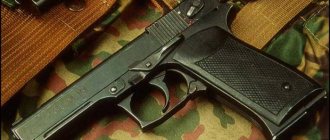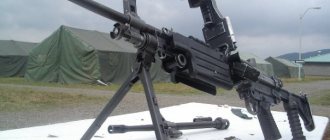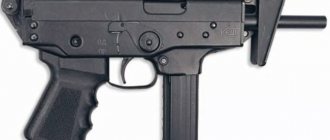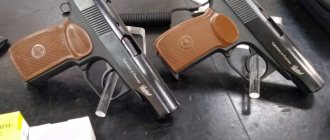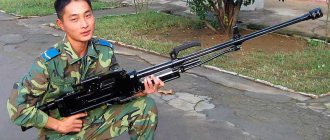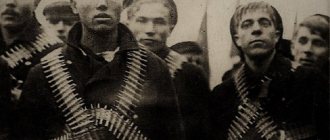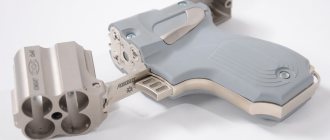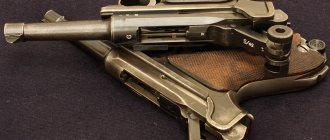The weapons business does not stand still. After the collapse of the Soviet Union, the arms industry in the Russian Federation was one of the few that did not fall into complete decline. Gunsmiths continued to develop new designs. In particular, in the context of modern conflicts, submachine guns occupy an important place. Far superior to a regular pistol in firepower, they are inferior to a machine gun in penetration ability, leaving it far behind in stopping power. This determined their priority in use by law enforcement agencies. Today we will talk about three relatively new weapon models: PP-91 “Kedr”, PP-19 “Bison” and AEK-919 “Kashtan”.
PP-91 "Kedr"
The weapon was developed by the creator of the legendary SVD rifle , known far beyond the borders of the former USSR, Evgeniy Fedorovich Dragunov , in honor of whom the name is abbreviated - pistol - machine gun model 19 91 , designed by Evgeniy Dragunov .
Like many modern types of weapons, automation is ensured by the recoil energy of the free shutter under the influence of powder gases. Both automatic and single-fire modes are provided. The magazine is double-row, box-type, with 20 or 30 rounds. The weapon is equipped with a metal folding stock; a silencer and a laser target designator can be connected to it. Designed for ammunition supply with 9x18 mm PM , but there are a number of modifications for 7.62x25 TT, 9x19 mm Parabellum, 9x17 mm Kurz , which are not widely used and remain experimental samples.
PP-91 "Kedr"
In terms of its stopping effect and damaging properties, the Kedr can be compared with a PM that fires in bursts. The initial flight speed of the bullet, like that of the PM, is 310-315 m/s , the target range is 50 meters. Weight with loaded magazine – 1.82 kg.
In Russia, the Kedr PP is in service with the Ministry of Internal Affairs, the Federal Penitentiary Service, the Russian Guard, bailiffs, collectors and couriers.
Caring for castanospermum at home
Temperature
The plant needs warmth all year round. So, it feels best at a temperature of 16 to 23 degrees. It should be taken into account that in winter the temperature in the room where the indoor chestnut is located should not fall below 16 degrees.
Illumination
It feels best in light partial shade, but the plant must be protected from direct sunlight.
How to water
In the warm season, you need to water abundantly, but you need to make sure that the liquid does not stagnate in the soil. For irrigation, you should use water only at room temperature. In the cold season, watering should be moderate. In this case, it must be carried out as the substrate dries.
In winter, the plant needs regular spraying. To do this, take well-settled lukewarm water.
Earth mixture
Suitable soil should be loose and neutral acidity. To prepare a suitable soil mixture, you need to combine leaf, turf and compost soil, as well as coarse sand, which should be taken in equal parts. It is also recommended to add some lumps of clay and brick chips. Don't forget about a good drainage layer.
Fertilizer
Indoor chestnuts need to be fed all year round once every 2 weeks. For this, organic fertilizers are used.
Features of transplantation
After the grown castanospermum has used all the beneficial substances that are in the cotyledons, it will be necessary to transplant it into a larger pot. At the same time, during transplantation, do not forget that indoor chestnut has very powerful roots.
Reproduction methods
This plant can be propagated by seeds. Before sowing, the seeds are immersed in warm water for 24 hours. Then they are germinated, for this purpose maintaining a constant temperature of 18 to 25 degrees.
The tree does not bloom in indoor conditions.
Pests and diseases
Mealybugs, thrips, spider mites or scale insects can settle on the plant.
Due to improper care, the following difficulties may arise when growing indoor chestnuts:
- Pale color of foliage - the plant does not have enough light.
- Plant growth has slowed down and needs feeding.
- Dried tips of leaves indicate too dry air; you need to spray your indoor chestnut tree more often.
- Yellowing of foliage in summer is due to intense lighting.
- In winter, the foliage withers and falls - the room is very cold.
PP-19 "Bison"
It is noteworthy that the development of weapons was carried out by the sons of such great designers as M.T. Kalashnikov is the creator of the legendary AK (by Viktor Mikhailovich), and E.F. Dragunov, who designed the SVD (by Alexey Evgenievich).
"Bison" was developed by order of the Ministry of Internal Affairs of the Russian Federation. The weapon, although still chambered for the same 9x18 mm , turned out to be much more effective than the Kedr.
Such good quality was achieved due to the unification of spare parts with the AKS-74U , with which the Bison has over 50% of common parts, including the receiver. A characteristic, rather rare design solution among domestic SMGs is the presence of an under-barrel auger magazine for 64 rounds.
PP-19 "Bison-2"
The tactical and technical characteristics are impressive: with a mass of various modifications ranging from 2.7 to 3.2 kg, the effective firing range ranges from 100 (for models with 9x18 mm PM) to 200 meters (for 9x19 Parabellum and 7.62x25 mm TT). There are about 13 different modifications, including the Vityaz PP in three different versions.
The PP has an open sight; on the left side there is a mount for sighting devices. It is in service with the FSB, FSIN, special forces of the Russian Guard and the Ministry of Internal Affairs, bailiffs, and couriers . Abroad adopted for service in Venezuela, North Korea, Vietnam, Bosnia and Herzegovina.
Green Way
September-October in Crimea and Ukraine is the time to collect horse chestnut fruits. However, for us he is just a chestnut, we don’t know anything else. Only in the Nikitsky Garden and the parks of the South Coast will you see an evergreen chestnut with edible fruits, about which the French have a saying: “I will not be a monkey who takes chestnuts out of the fire for you.” Spanish castanets are also not from our chestnut. But as an ornamental breed, horse chestnut is much more spectacular than the edible one. In addition, it has healing and cosmetic properties and is used as a raw material for the production of medicines .
Our chestnut impresses with its pronounced aspects, in winter with the filigree pattern of its branches, naturally with incredibly harmonious graphics. The contrast of fluffy snow on the black ornament of the chestnut crown is mesmerizing. In early spring, the swelling buds are like the birth of alien monsters, and the shoots have the most delicate color and texture.
In May in Crimea, in Kyiv in June the flowering of chestnut fills the air with fragrance. The crowns seem to be covered with exquisite confectionery cream, and nearby the blooming chestnut cluster is something like jewelry. A large chestnut leaf transpires water vapor into the atmosphere, softening the climate, while the crown collects dust and harmful impurities from the air.
The root system on sandy soils drives water to the leaves even in drought. The best natural (soil-climatic) conditions for the natural regeneration of horse chestnut are in the north of the Nikolaev region of Ukraine, on sandy soils near river valleys, which soften sharp fluctuations in air temperature. Self-seeding (germination of chestnuts) here reaches such an extent that in spring the soil under the trees looks like a green lawn from sprouted fruits.
But in Crimea, chestnut suffers from limestone (carbonate) soils, the leaves rust already in August.
In the Salgir Valley, on the river sediments of the floodplain and terraces, chestnut can live for 200 years. But the tree grows as quickly as poplar and sycamore, but directly from the fruit! And at the same time, an allergy from chestnut was not noticed. Its crown tolerates curly pruning, thinning, and rejuvenation. Chestnut is modeled in any style of classical architecture and high-tech. The horse chestnut fruit is smooth, glossy with a delicate moire pattern showing through the elegant red-brown color. For small children this is a treasure.
The truth speaks with the hands of a baby just as accurately as with the lips: the fruits of horse chestnut are purchased by pharmacies for processing into medicines and perfumes; chestnuts are widely used in folk medicine.
In human fingers, the nerve endings are connected not only with the brain centers, but also with the healthy functioning of all internal organs. By choosing 3 round chestnut fruits that are comfortable for the palm of your hand, you will receive a biopositive massager, especially beneficial for those who work with a keyboard. The calming effect of looking at, stroking, collecting and the feeling of owning such a beautiful object gives a powerful effect in art therapy for mentally ill people and children with hyperactivity. Crafts and toys made from chestnut trees, hand-made are the path to perseverance, concentration, creativity, and the joy of work.
Ukrainian pharmacies, especially in the Nikolaev region, accept horse chestnut fruits for processing into medicines. It is known that preparations from pavia fruits slow down blood clotting and are used to prevent blood clots in blood vessels .
Horse chestnut blooms for about 25 days, honey plant !
Pavia fruits are the most valuable raw material for preparing massage mixtures . It is especially useful for those who suffer from varicose veins, radiculitis, and arthritis.
Bags of horse chestnut fruits, laid out on shelves in the closet, will repel moth butterflies and also destroy their larvae. Don’t forget about the kitchen cabinets: a few chestnuts there will help get rid of insects!
But still, why is it not the edible Mediterranean chestnut that is most expensive the red one ?
How to grow Italian red chestnut?
1. Park name Horse chestnut. The botanical name is pavia (lat. Aesculus pavia).
2. It became known as the Italian red chestnut because of a scandal: in Italy, 250 large chestnut seedlings were purchased for Kyiv for a huge sum. Of these, only 2 bloomed with red inflorescences. 3. In Simferopol, on Lenin Street near Sovetskaya Square, three red chestnut trees grow.
Somewhere in the late 1970s, the chief forester of the Simferopol Special Forestry Agency grew seedlings in his nursery. However, he later abandoned breeding - out of hundreds of red chestnut seedlings, only a few inherit their parental properties.
Most red-flowering chestnut fruits grow into ordinary trees. This means there is no question even about park uniform, much less breed or variety. Red chestnut is a rare game of nature, hence the price for black pearls is hundreds of times higher than usual. The price for an ordinary horse chestnut seedling, even though it comes from red fruits, cannot be thousands of euros. So, in order to get several red chestnut seedlings, you need to collect a couple of hundred fruits, for example, from Simferopol red chestnuts. Plant them in a nursery school and grow them until the first flowering for about 10 years. Well, then it’s like a lottery. Winning is not guaranteed. There may be zero red chestnuts out of 300 seedlings.
The matter is not troublesome, it requires land, it is easier than with fruit trees. Ordinary chestnuts are good for landscaping, but you can buy a car for a couple of red ones.
AEK-919 "Chestnut"
Developed in the mid-90s of the last century in the design bureau of the city of Kovrov by a group of designers led by P. Sedov, M. Tarasov and S. Koksharov. The PP was “copied” from the Austrian analogue Steyr MPi-69 . After the production of the experimental model, shortcomings were revealed, and the weapon underwent significant improvements. The new model was given the abbreviation AEK-919K.
Initially, it was intended to use the Kashtan as a weapon for crews of tanks, helicopters, armored personnel carriers, and special forces of the Ministry of Internal Affairs. The first combat use dates back to 1995, during the First Chechen Campaign. In 2002, the crews of combat helicopters operating in the Chechen and Dagestan territories were equipped with this type of weapon.
PP AEK-919K "Kashtan"
Since 2003, the AEK-919 has been in service with the FSSP of Russia . Also, until 2006, units of the Ministry of Internal Affairs, the Federal Penitentiary Service, the FSO and the FSB . Today he remains in the service of the FSUE Okhrana belonging to the Russian Guard.
The weight of the PP with a loaded magazine is 1.78 kg, ammunition is supplied by the same 9x18 mm PM . The aiming and effective firing range are the same and amount to 100 meters . Equipped with a folding stock, it is possible to mount a collimator or laser target designator. The magazine comes with a capacity of 20 or 30 rounds.
This unique list of submachine guns in service in Russia is far from exhaustive.
We have only listed the three most frequently mentioned models, but in total there are about fourteen of them, not counting the various modifications of each of them. Subscribe to our channel in Yandex Zen
At the end of the 20th century, such firearms as the submachine gun were forgotten, but in the second half of the 90s, interest in it appeared again. Numerous criminal groups began to acquire foreign-made weapons, including submachine guns. The security forces, especially the Ministry of Internal Affairs, needed their own equivalent small arms - compact, fundamentally new.
The AEK-919 “Kashtan” submachine gun was developed in the late 90s taking into account the tactical and technical requirements of the Russian Ministry of Internal Affairs. The Austrian SteyrMPi-69 software was taken as a basis, but after the release of the first models, very significant shortcomings were found and changes were made to its design. After the change, the submachine gun received the designation AEK-919K. "Kashtan" was developed and began to be produced at the Kirov Mechanical Plant (KMZ). Pavel Sedov was appointed chief designer.
Appearance
It has four modifications: AEK-918, AEK-918B, AEK-919 and, in fact, AEK-919K.
Design
Both externally and structurally, the submachine gun is similar to a simple short-barreled pistol, only larger in size and has a small fore-end, in the form of two groups of notches, which is very helpful for precise aiming. The principle of reloading is the same as for pistols - due to the recoil of the free bolt, only the bolt is hidden behind a protective casing. It has a retractable (telescopic) metal buttstock, which can change the angle of the butt plate by as much as 180 degrees. However, it has a minus - it is short.
In order to reduce the dimensions, a ram-type shutter design was used. Thus, approximately a third of the bolt in its rearmost position covers the barrel.
The barrel bore is cut in a tetrahedral polygonal form. Unlike a rifled barrel, due to its shape, polygonal rifling reduces the amount of free powder gases released. This increases the initial speed of the bullet, its more accurate flight direction, and the accuracy of fire. It is also convenient when cleaning weapons.
There are two types of magazines for PP - designed for 20 and 30 rounds, loaded into the handle. Ammunition is located in the magazine in a checkerboard pattern, double row. The PP can be loaded with both conventional cartridges and modified ones - 9x18M, with increased power of the powder charge. The high-strength material from which “Kashtan” is made—glass-filled plastic (glass-filled polyamide)—has become unusual for weapons produced in Russia. The PP frame is molded from it, as is the lower receiver area. In turn, the upper area is made of steel.
The USM supports firing with single shots and bursts. Switching firing modes is carried out by a metal flag located on the left side, above the trigger guard. This arrangement of the checkbox makes it somewhat difficult to switch. Push-button fuse.
The AEK-919K is equipped with its own body kit - additional devices to increase the convenience and efficiency of shooting. It can be equipped with a laser target designator, a collimator sight, and a muzzle attachment for flameless and low-noise shooting.
The simplicity of the design makes it very easy to care for the weapon. It has also become very convenient that the barrel can be quite easily disconnected from the submachine gun. It screws onto the threads in the receiver. This also ensures quick replacement when the barrel wears out.
To be honest, especially the first modification, the AEK-919, is very similar in appearance and design to the Israeli Uzi.
Carrying a weapon can be done in two ways - on a belt, which is attached to the back of the receiver, or in a carrying bag, where there are pockets for magazines and a sight.
Main technical characteristics of PP "Kashtan"
Below, in the form of a list, the main characteristics (performance characteristics) of the specified type of small arms are collected:
- total length of the weapon, mm - 423/590;
- weapon height, mm - 242;
- maximum weapon width, mm - 70;
- total barrel length, mm - 250;
- PP weight, kg - 2.41;
- weapon caliber, mm - 9;
- number of barrel rifling - 6;
- the direction of the rifling in the barrel is right;
- barrel rifling angle - 6 degrees;
- the angle between the reflector and the ejector hook is 175 degrees;
- striker diameter, mm - 2.2;
- reflection of cartridges - to the right of the shooter;
- the principle of operation of the automation is the recoil of the free shutter;
- barrel locking mechanism - inertial principle;
- USM - bolt type;
- fuse - push-button;
- the ammunition used is pistol, caliber 9x18;
- magazine type - detachable box-shaped;
- maximum magazine capacity, cartridges - 20 or 30.
Application
The submachine gun is used in close combat, at a range of up to 100 meters. It is convenient because it is small in size, thereby allowing the use of weapons in confined spaces, arming soldiers who serve in armored vehicles or aircraft, so that, if necessary or when performing a combat mission, they can quickly and without hindrance leave the vehicle. It is also convenient to use PP when storming buildings, which is very important, since in numerous rooms you need to quickly change the direction of fire. This significantly influences the choice of weapons under such conditions and creates competition for the usual AKSU.
Since the PP is equipped with a pistol cartridge, the firing range is much shorter than that of the same Kalashnikov. This gives the weapon a big advantage, for example, when freeing hostages in buildings - the ricochet from the shot is weaker, thereby reducing the likelihood of accidentally hitting civilians.
The AEK-919 is designed for 9 mm ammunition, which is used to load the well-known PM, which makes it easier to replenish ammunition. “Kashtan”, unlike the vast majority of other submachine guns, managed to “light up” in armed conflicts. FSB officers were the first to use it; its baptism of fire occurred in 1995 in the Chechen Republic. The leadership of the Russian FSB placed an order and received a batch of one hundred pieces. Judging by the serial numbers, these were prototypes. Later, in 2002, they were supplied to helicopter pilots of the Armed Forces.
This type of firearm was fully tested in 2004, and with honors. However, already in 2006, production was discontinued due to a change in the profile of KMZ and the liquidation of SKB. But, despite the rather short production period, “Kashtan” became quite widespread. The FSO, the Ministry of Internal Affairs, the Federal Penitentiary Service and the FSB of Russia armed their units with it.
Results
In general, judging by the characteristics of the manufacturers and the reviews of special forces personnel, the AEK-919 “Kashtan” is an accurate, reliable, modern weapon. Due to its dimensions, and in the AEK-919K modification – also smoothed shapes, the PP can be hidden under clothing. Employees of the Ministry of Internal Affairs pay a lot of attention to this characteristic.
At the moment, there are options for pneumatic and traumatic weapons created on the basis of the AEK-919, which use rubber bullets.
Similar
Beneficial properties of edible chestnut nut
As a fruit species, chestnuts are of great value: they are eaten raw, fried, baked, made into flour, butter, jam, coffee, and used in the preparation of confectionery. Raw chestnut fruits are very nutritious, have a high content of proteins and carbohydrates, they contain vitamins B, C, malic and citric acids. The raw kernel of the large-fruited Azerbaijani chestnut nut contains (in%): water 55.46% water, 28.22% carbohydrates, 4.39% protein and 1.36% fat. Small-fruited - 32.82% water, 47.29% carbohydrates, 4.62% protein and 1.68% fat. Green and yellowed chestnut leaves are also considered medicinal: 1 gram of fresh leaves contains 800 biological units of vitamin K (dried leaves - about 600). Chestnut plays a great role in beekeeping - unique chestnut honey is very tasty and healthy. But in addition to the fruits, the wood of this tree is of great value. It has a beautiful structure, is easy to process, is resistant to rotting, is used for making furniture, musical instruments, in construction, is used for plywood, riveting, etc. It is valued on a par with oak. That is why chestnut groves in the North Caucasus suffered (and are still suffering) greatly from illegal logging.
How to eat roasted chestnuts (video)
People who see chestnuts for the first time in their lives often have this question. In fact, this process is practically no different from how you should eat your usual hazelnuts, walnuts or peanuts. Whether raw or cooked, chestnuts must be peeled to remove the outer hard brown skin. This is easy to do with a knife (or without it, just biting it with your teeth), after which the nut itself (it is soft) can be eaten. There is no need to free the fruit from its light brownish thin shell, unless you are glazing chestnuts in sugar.
The main foreign varieties of chestnut
The most valuable fruits are chestnuts, which are distinguished by their mealiness. Varieties such as Marron (de Lyon) and franc de Limon have particularly large and sweet fruits. Foreign varieties of chestnut: Large-fruited - grows in Azerbaijan. The fruits are flat-round in shape, light chestnut in color, very large, 25-30 mm high, 28-36 mm wide, 18 mm thick and fresh weighing 7-12 g. Small-fruited (Azerbaijan) - fruits weighing 4.5- 6.5 grams, broadly ovoid, black-brown. Lyons is the most famous in world trade. The fruits are very large, 1 or 2 in a row. The peel is thin, light chestnut or reddish, shiny. The kernel is yellowish-white, very sweet, of excellent taste. Ripens at the end of summer. Trees of this variety are common in the south and center of France, Italy and Spain. The fruits are used fresh and in confectionery production. Many fruits of this chestnut are exported from France. Bourou de lillac is a French variety. A beautiful and productive tree, little demanding of soil, but sensitive to cold. The fruits are very large (60-70 pieces per 1 kg), dark brown. The kernel is yellow, with very dense and sweet pulp. Neapolitan is the largest-fruited variety of European chestnut. The average weight of the fruit is 20 g, but can reach 60 g. The fruit is round in shape, 1-2, sometimes 3 in a very large plus. The peel is reddish-brown. The kernel is dark yellow, dense, of good quality, but inferior in taste to Lyon. Usually used in confectionery production. In culture, it is most common in Italy and France. It should be noted that Russian North Caucasian chestnuts are much smaller in size than the fruits of foreign varieties. They are smaller in size, but are much easier to clean than foreign varieties.
Russian chestnut is often small in size.
Selling chestnuts on the street: OKVED, tenders and equipment
The main OKVED code for selling roasted chestnuts on city streets is 47.1 retail trade in non-specialized stores. For street trading in parks and other crowded places, you need to win tenders held by municipalities for the right to locate retail facilities (stalls, retail outlets). Notices about their implementation are usually posted on the administration’s websites at the beginning of the year (February-April). If the owner of the land plot is not a municipality, but a commercial or non-profit structure, then the terms of lease of the land plot must be negotiated with the owner. You can also set up a sales point with roasted chestnuts at events, for which you need to negotiate with their organizers. The most inexpensive equipment may look like an oven or frying pan with a branded table. Abroad, street chestnut vendors look like this:
Where unique edible chestnut groves grow in Russia
Chestnut requires a warm climate and high soil and air humidity; the optimal amount of annual precipitation ranges from 1000 to 1500 mm. In Russia, edible chestnut groves grow in the Caucasus, on the southern slopes of the mountains, near the Black Sea along the rivers Tuapse, Shakhe, Sochi, Psou, Mzymta, on the slopes of Mount Aibga, etc. These are the territories of Tuapse, Maikop, Pshishsky and other forestries. Chestnut groves grow in the Maykop region on the territory of the Pervomaisky forestry of the Pervomaisky timber industry enterprise. There are trees here that are over 100 years old. In general, the sowing chestnut is a representative of the ancient flora, which traces its history back to the Tertiary era. The tree can live up to 500 years. Just imagine what a relict plant this is! Chestnut grows well and bears fruit in prolonged warm weather, but does not tolerate heat and drought, so it can be more often found on shaded northern and northeastern slopes, in the depths of gorges. As a rule, trees cannot be found in open areas. On average, chestnut trees begin to bear fruit from the age of 20, the yield increases up to 60 years and remains at approximately the same level until 140 years, it blooms and bears fruit annually, giving abundant harvests after about 6 years. And now about the bad. Today, experts are concerned about the condition of chestnut trees within their natural range, which is shrinking from year to year. Unsystematic logging and, as a consequence, the spread of diseases and pests are destroying the chestnut forests of Russia. According to a forest pathological survey conducted in 1999, the area of chestnut tree plantations with unsatisfactory sanitary conditions in the Pshishsky forestry enterprise was about 21%, which is more than 2,000 hectares.
